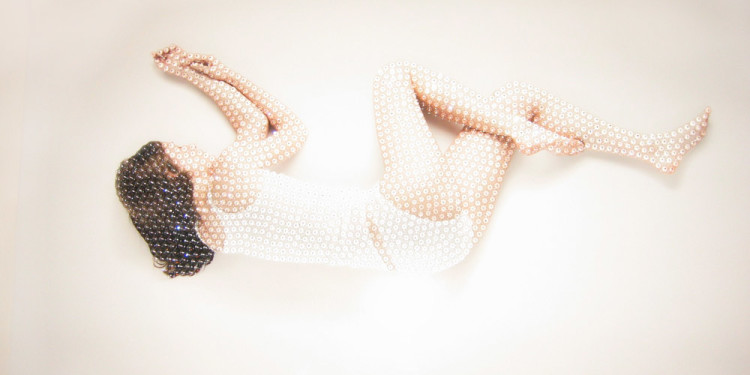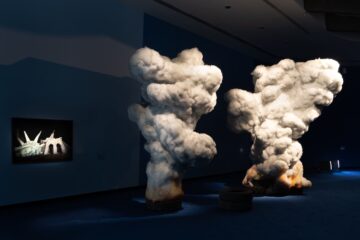SHADOWED BY THE WHITE – ALL’OMBRA DEL BIANCO


Text by Vittoria Biasi
Shadowed by the White
Thai Artists
Amrit Chusuwan, Sakarin Krua, Sittichai
Italian Artists
Fabrizio Corneli, Alessandra Porfidia, Stato di Famiglia, Maria Chiara Calvani
All the cultures are united by the symbology of tree and shadow. Some peoples think that the shadow of the brambles in the night hides mean sprites who frighten the wayfarer. In our imagination the physical and psychic dimension fuse together to find out the freedom. In “going through rituals the natural symbols are very important mesh, connection points”. In such a sense it is possible to track a history of the shadow starting from the redeeming conception through the western culture up to the Buddhist inspiring one. Working with the memory, the imagination devotes the shadow to a poem of the mind, to a white (without colour) place where ones own soul can have a look around, of inner figurations.
From the idea of shadow, as a place of becoming, originates the project of meeting between the Thai Buddhist culture and the Western one through the works of the artists Amrit Chusuwan, Sakarin Krua, Sittichai e Fabrizio Corneli, Maria Chiara Calvani, Alessandra Porfidia, Stato di Famiglia.
A history of cultural swaps goes through the Western and Eastern world. The 20th century develops a procedure of an unusual research, into which the artistic world get close to the reality of the every day facts. In the Western world during the second half of Nine hundred century we witness a phenomenon of reality appropriation, which comes out as a poetics of things, objects. The up to date languages put an idea of wish and contact with the world into action, they outline an artistic landscape which assumes the simple behaviour, the every day pleasure, the emotional research of a feeling of love. The glance at the surrounding penetrates the core of things and makes it resurface through an animistic process. The new connection is rooted into the relationship with the eastern cultures during the first years of Nine hundred century and pinpointed during the second half of the same century.
The history of Thai modern art starts to make cultural exchanges with the West and it is greatly developed thanks to Silpa Birasri’s involvement (Corrado Feroci), during 1923 appointed sculptor at Fine Arts Department, becoming during 1943 the first Rector and Academic Principal of Faculty of Paintings and Sculpture. The influence of some Western cultural trend, among the others in a specific way the Impressionism and the Abstractionism, and the student movement during 1973, they trod a new path into the Thai art. The student movements looked for dialogue with the reality, telling social histories and accepting the admission of new media into the artistic expressiveness, sidestepping concerns of the traditional fiction oblivious of perspective conception about the space and chiaroscuro. The elaboration and the synthesis of a path and of a dialogue with its shifts occur, for some artists, inside the aesthetics and the Buddhist philosophy.
The proposed artists are representative of a particular nature of Thai world, that one is swarming around the old town’s streets, near by the temples, repository of traditions, of the circular conception of life. Amrit Chusuwan, Sakarin Krua, Sittichai put at the centre of their research the respectfulness for a gestural and behavioural rituality, of some appearance for the daily life and talk to the spurs of the globalized world, looking for the entrance or the connection where from it is possible to reconstruct the Buddhist thought. Amrit Chusuwan applies the philosophical wisdom to small objects which are means by which is possible to reach perception of a world covered by veils and be able to capture the difference between the being and the appearance. The artists discover the tale of the daily life to reach the great philosophic topics. The large Sittichai’s mandala is built through the child’s innocence repeating the same form in order to create an unforeseen construction, and he plays asking himself questions whose reply is already known by himself.
Sakarin Krua shapes his histories, follows his teachings through smallest materials to the limit of unseen to reach its object visibility! It is the Buddhist harmony of gesture applied to the visual art or to the art of garlands realized with magnetic rituality by the little sellers around Bangkok’s streets. Along this path of handiwork, of ritual works, of research of a way to reach the vision, the poetics of Thai artists wed with the Italian ones. The anamorphosis of Fabrizio Corneli obtains from horizontal ability to plan through an optical and percipient technique an allusive figuration for inner narrations between the shadow and the light. Alessandra Porfidia superimposes flat surfaces and lines, as a stage of hidden spaces, of concrete worlds in the execution of a rituality getting awareness of new meditative places and attention for acts movements originating every things.
The artists Stato di Famiglia complete the poetics of construction revising the picture (photo image) into the appealing world of Swarovsky crystal, giving to the rituality the meaning of reminder for the reality and its impressiveness.
The experience among the different artists like Maria Chiara Calvani, Fabrizio Corneli, Alessandra Porfidia and Amrit Chusuwan, Sakarin Krua, Sittichai brings about the construction of a planning affinity between the Thai Buddhist thought and the Oriental Catholic one of the Western world.
Vittoria Biasi

Testo di Vittoria Biasi
All’ombra del bianco
Artisti Thailandesi
Amrit Chusuwan, Sakarin Krua, Sittichai
Artisti Italiani
Fabrizio Corneli, Alessandra Porfidia, Stato di famiglia, Maria Chiara Calvani
La simbologia dell’ombra accomuna tutte le culture. Presso alcuni popoli l’ombra dei rovi nella notte nasconde spiritelli cattivi che spaventano il viandante. Nelle vie dell’immaginario, la dimensione fisica e psichica si fondono verso una ricerca di liberazione. Nel “tessuto rituale i simboli naturali costituiscono delle maglie importanti, dei punti di raccordo”. In tal senso è possibile tracciare una storia dell’ombra dalla concezione salvifica nella cultura occidentale, fino a quella buddhista, illuminante. Lavorando sulla memoria, l’immaginazione consacra l’ombra a poesia della mente, a luogo bianco, incolore di ricognizione dell’anima, di figurazioni interiori.
Dall’idea di ombra, quale luogo del divenire, nasce il progetto di incontro tra la cultura buddhista della Thailandia e quella Occidentale, attraverso le opere degli artisti Amrit Chusuwan, Sakarin Krua, Sittichai e Fabrizio Corneli, Alessandra Porfidia, Stato di famiglia.
Una storia di scambi culturali percorre l’Occidente e l’Oriente. Il XX secolo sviluppa un procedimento di singolare ricerca, in cui il mondo artistico si avvicina alla realtà del quotidiano. Nella seconda metà del Novecento in Occidente si assiste ad un fenomeno di appropriazione del reale, che emerge come poetica delle cose, degli oggetti. I nuovi linguaggi pongono in atto un’idea di desiderio, di contattato con il mondo, tracciano un panorama artistico che assume il comportamento semplice, il piacere quotidiano, la ricerca emotiva di un sentimento di amore. Lo sguardo sul circostante penetra il profondo delle cose e lo fa riemergere con un procedimento animistico. Il nuovo rapporto ha radici nella relazione con le culture orientali, agli inizi del Novecento e puntualizzate nella seconda metà del secolo.
La storia dell’arte moderna Thailandese inizia con gli scambi culturali con l’Occidente ed ha un grande sviluppo grazie all’impegno di Silpa Birasri (Corrado Feroci), nel 1923 nominato scultore presso il Dipartimento di Belle Arti, divenendo nel 1943 il primo Rettore e Direttore Accademico della Facoltà di Pittura e Scultura. L’influenza di alcune correnti culturali dell’Occidente, tra cui principalmente l’impressionismo e l’astrazione, e i movimenti studenteschi del 1973 hanno tracciato un nuovo percorso nell’arte Thailandese. I movimenti studenteschi hanno cercato il dialogo con la realtà, raccontando storie sociali e accettando l’ingresso di nuovi media nelle espressività artistiche, eludendo le preoccupazioni della narrativa tradizionale ignara della concezione prospettica dello spazio e del chiaroscuro. Per alcuni artisti l’elaborazione e la sintesi di un percorso e di un dialogo con i mutamenti avvengono all’interno dell’estetica e della filosofia Buddhista.
Gli artisti proposti sono rappresentativi della particolarità del mondo Thailandese, quello che brulica nelle vie del centro storico, vicino ai templi, depositari della tradizione, della concezione circolare dell’esistenza. Amrit Chusuwan, Sakarin Krua, Sittichai pongono al centro della ricerca il rispetto di una ritualità gestuale e comportamentale, dell’estetica del quotidiano e dialogano con le sollecitazioni del mondo globalizzato, cercando l’accesso o il contatto da cui ricostruire il pensiero buddhista. Amrit Chusuwan applica la saggezza filosofica ai piccoli oggetti, che sono veicoli per raggiungere la percezione di un mondo coperto da veli e catturare la differenza tra l’essere e l’apparire. Gli artisti scoprono la favola del quotidiano per raggiungere i grandi temi filosofici. Il grande mandala di Sittichai è costruita con l’innocenza del bambino che ripete la stessa forma per creare una costruzione inattesa, giocando a porsi una domanda di cui conosce la risposta. Sakarin Krua costruisce le sue storie, insegue i suoi insegnamenti con materiali minimi al limite dell’invisibile per raggiungerne la visibilità oggettuale! E’ l’armonia buddhista del gesto applicato all’arte visiva o all’arte delle ghirlande realizzate con magnetica ritualità dai piccoli venditori lungo le vie di Bangkok. Lungo questo sentiero di artigianalità, di costruzione rituale, di ricerca di percorso per giungere alla visione le poetiche degli artisti Thai si coniugano con quelle degli artisti Italiani. L’anamorfosi di Fabrizio Corneli ricava dalla progettualità orizzontale, attraverso un procedimento ottico e percettivo, una figurazione allusiva a narrazioni interiori tra l’ombra e la luce. Alessandra Porfidia, sovrappone piani e linee, quali stadi di spazi celati, di mondi concreti nell’esercizio di una ritualità che porta alla consapevolezza di nuovi luoghi meditativi e all’attenzione per gesti movimenti che sono all’origine del tutto. Gli artisti Stato di Famiglia completano la poetica della costruzione rielaborando l’immagine fotografica nel mondo affascinante dei cristalli Swarovski, dando alla ritualità il senso della rievocazione del reale e della sua l’imponenza.
L’incontro tra gli artisti Fabrizio Corneli, Alessandra Porfidia, Stato di Famiglia, Maria Chiara Calvani e Amrit Chusuwan, Sakarin Krua, Sittichai determina la costruzione di un’affinità progettuale tra il pensiero buddhista thailandese e il pensiero cattolico-orientale dell’occidente.
Vittoria Biasi
Vernissage IN THE SHADOW OF WHITE – ALL’OMBRA DEL BIANCO
http://www.facebook.com/events/193756804069549/
Galleria Edieuropa – Qui arte contemporanea, Roma
http://www.galleriaedieuropa.com/
.-.-.-.
In the shadow of white
(All’ombra del bianco)
Thailandese Artists: Amrit Chusuwan, Sakarin Krua, Sittichai Pratchayratikun
Italian Artists: Fabrizio Corneli, Alessandra Porfidia, Stato di famiglia, Paola Maria Chiara Calvani.
Exhibition attended by Vittoria Biasi
Opening on Sunday 29th March 2012 at 11:00 AM
Shadow symbology is put on a par by all cultures, from Westerly idea of salvation and perspective up to that of Buddha, inspiring. In all rites the natural symbols are very important post, are connections to conquest the thin essence of man. The exhibition All’ombra del Bianco, proposed by Edieuropa and attended by Vittoria Biasi, covers some possible trails around the uncatchable meaning of white and shadow. Imagination consecrates the shadow to a poetry of mind close to white, working on memory, place of becoming, of scouting around the soul, of inner figurations.
The project proposes the meeting between the Buddha philosophy of the Thais artists Amrit Chusuwan, Sakarin Krua, Sittichai Pratchayratikun and a scientific-literary way of the West expressed by the works of the artists Fabrizio Corneli, Maria Chiara Calvani, Alessandra Porfidia, Stato di famiglia.
From the second half of twentieth century, in the West, we have been witnessing a case of comeback of real, that appears as a poetry of things, practice of object. The new languages put an idea of wish in action, of keeping in touch with thr world, map out an artistic survey that assumes the simple behaviour, the pleasure for the daily, the emotional search for a feeling. The look in the surrounding penetrates the depths of things and make it resurface by a ritual close to Oriental practices. The philosophic search of Thais artists, aware of an identity far away from global culture, get married to the scientific research of Italian artists Fabrizio Corneli. The rhythmic scansion in Alessandra Porfidia, Maria Chiara Galvani, Stato di famiglia works around an act which in different ways look for the power of a real or fictitious white thread that links all the languages with one’s own history both artistic and human.
The exhibition will be open from 29th March up to 24th April 2012. Hours: from 11:00 a.m. to 07:00 p.m. Closed on Monday and public holidays.
Galleria Edieuropa – Qui arte contemporanea – www.galleriaedieuropa.com
Piazza Cenci, 56 – Roma – Tel. +39 0664760172 – edieuropa@tiscali.it
Download: Comunicato stampa all’ombra del bianco
La mostra resterà aperta dal 29 marzo fino al 28 aprile 2012.
Position the cursor on the images to view captions, click on images to enlarge them.
Posizionare il cursore sulle immagini per leggere le didascalie; cliccare sulle immagini per ingrandirle.


























No Comment